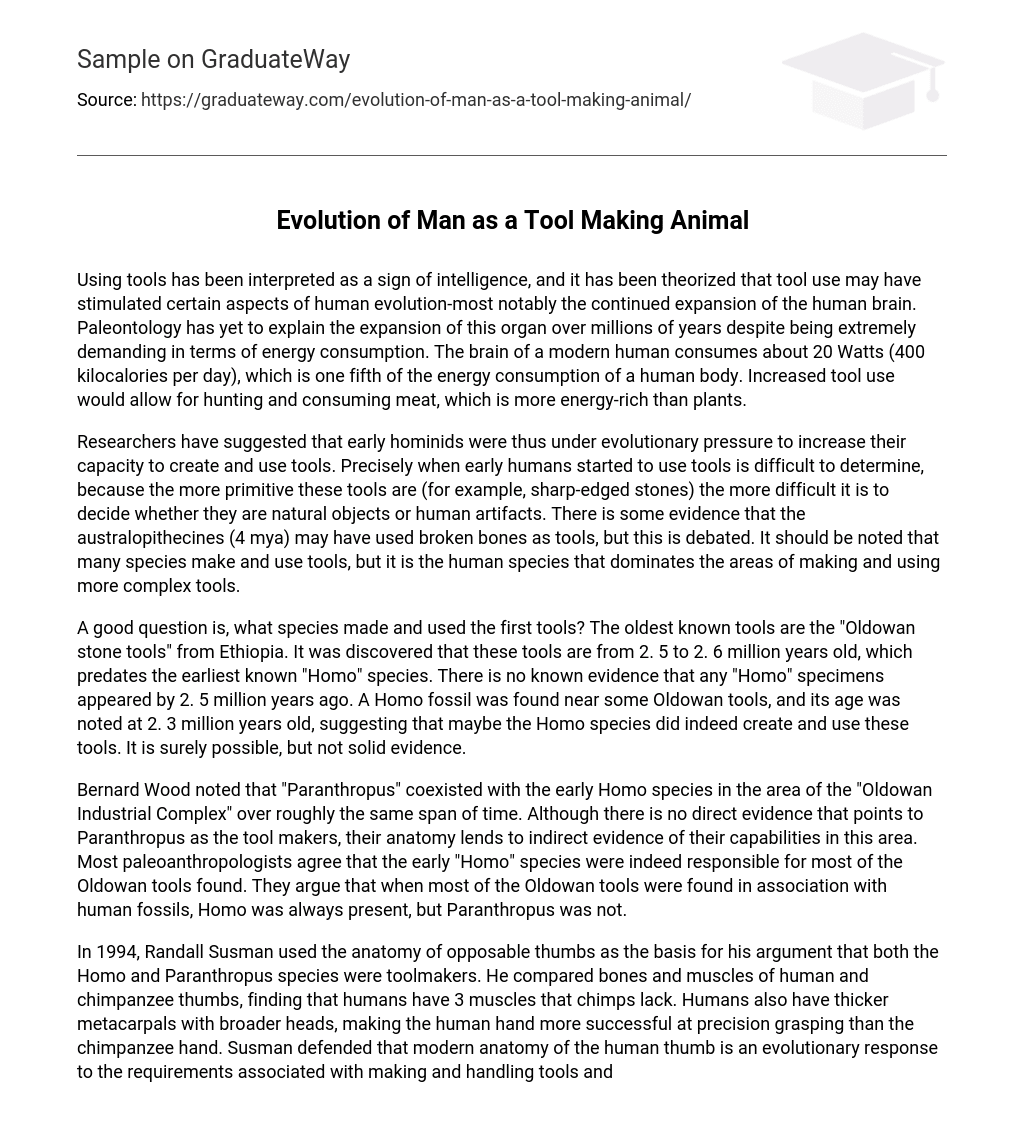Using tools has been interpreted as a sign of intelligence. It has been theorized that tool use may have stimulated certain aspects of human evolution, most notably the continued expansion of the human brain. Despite being extremely demanding in terms of energy consumption, paleontology has yet to explain the expansion of this organ over millions of years.
The brain of a modern human consumes about 20 Watts (equivalent to 400 kilocalories per day), which accounts for one fifth of the energy consumption of the human body. The ability to use tools more efficiently would have allowed early hominids to hunt and consume meat, which is more energy-dense than plants. As a result, researchers have suggested that early hominids were under evolutionary pressure to enhance their capacity for tool creation and usage.
Precisely when early humans started to use tools is difficult to determine. This is because the more primitive the tools are, such as sharp-edged stones, the more challenging it becomes to decide whether they are natural objects or human artifacts. Some evidence suggests that australopithecines (4 mya) may have used broken bones as tools, but this remains a topic of debate. It should be noted that many species make and use tools; however, humans dominate in making and using more complex ones.
A good question is, what species made and used the first tools? The oldest known tools are the “Oldowan stone tools” from Ethiopia. It has been discovered that these tools are 2.5 to 2.6 million years old, predating the earliest known “Homo” species. There is no evidence to suggest that any “Homo” specimens appeared by 2.5 million years ago.
A Homo fossil was found near some Oldowan tools, and its age was noted at 2.3 million years old, suggesting that maybe the Homo species did indeed create and use these tools. While it is possible, this is not solid evidence.
Bernard Wood noted that Paranthropus” coexisted with early Homo species in the area of the “Oldowan Industrial Complex” for roughly the same span of time. Although there is no direct evidence pointing to Paranthropus as the tool makers, their anatomy provides indirect evidence of their capabilities in this area. Most paleoanthropologists agree that early Homo species were responsible for most Oldowan tools found. They argue that when most Oldowan tools were found in association with human fossils, Homo was always present, but Paranthropus was not.
In 1994, Randall Susman argued that both the Homo and Paranthropus species were toolmakers based on the anatomy of opposable thumbs. He compared the bones and muscles of human and chimpanzee thumbs, finding that humans have three muscles that chimps lack. Additionally, humans have thicker metacarpals with broader heads, making their hands more successful at precision grasping than chimpanzee hands. Susman defended that modern anatomy of the human thumb is an evolutionary response to the requirements associated with making and handling tools, suggesting that both species were indeed toolmakers.
Stone tools were first used around 2.6 million years ago by H. habilis in Eastern Africa. These tools were known as pebble tools, which were choppers made from round pebbles that had been split by simple strikes. This marks the beginning of the Paleolithic era, also known as the Old Stone Age, which ended around 10,000 years ago with the conclusion of the last Ice Age. The Paleolithic era is divided into three periods: Lower Paleolithic (Early Stone Age), which ended approximately 350,000-300,000 years ago; Middle Paleolithic (Middle Stone Age), which lasted until approximately 50,000-30,000 years ago; and Upper Paleolithic.
The period from 700,000-300,000 years ago is known as the Acheulean. During this time, H. erectus (or H. ergaster) crafted large stone hand-axes out of flint and quartzite. Initially, these tools were quite rough (Early Acheulian), but later they were retouched” by additional subtle strikes at the sides of the flakes. After 350,000 BP (Before Present), a more refined technique called Levallois was developed. This technique involved a series of consecutive strikes to create scrapers, slicers (“racloirs”), needles, and flattened needles.Finally, around 50,000 BP, even more specialized flint tools were made by both Neanderthals and immigrant Cro-Magnons such as knives, blades and skimmers.





